
How the 2023 NFL draft’s leading pass receivers control in
These are boom times for NFL-bound wide receivers. The past 3 NFL drafts have actually seen an overall of 17 wideouts taken in the first round (the 3 drafts prior to that: seven), and almost half of them (7) have actually been selected 12th or greater. Each year the NFL jointly acknowledges the value of the death game a bit more– the last time a running back was selected higher than 24th: 2018– and receivers have actually benefited from that nearly as much as edge rushers.Incredibly, nearly none of these 17 first-rounders turned out to be reaches. 5 produced 1,000-yard rookie seasons, five of the remaining 11 picked in 2020-21 did so in their 2nd year, and three of the 5 from 2020(not including Henry Ruggs)did so in their 3rd, while a 4th came within 28 backyards of that mark. Select a pass receiver in the preliminary, and the chances are great that he’ll play like a first-round pick.Is the receiver position easier to forecast than others? Perhaps
. Of the 124 wideouts that(A )were drafted given that 2016 and(B)have seen at least 50 targets in the NFL– undoubtedly a rather self-selecting sample, since some busts might not have actually hit that mark– there are some good correlations in between college and professional production. There’s a connection of 0.47 *, for example, in between a player’s catch rate in college and his catch rate in the pros and a connection of 0.39 between lawns per catch at the 2 levels. Sports Info Solutions has actually been gathering detailed college path data since 2018, and for players drafted in 2021 or 2022, a player’s yards-per-route-run average at the 2 levels associates rather nicely(0.60 within this sample). * Correlations range from minus-1 to 1. If a connection isclose to 1, the two variables in concern rise and fall in strong positioning; if it is close to minus-1, the 2 variables are aligned in inverted– one increases while the other falls. If it is close to 0, there is almost no relationship between the two variables.What to understand for the 2023 NFL draft Ranks: Kiper|McShay|Positional Mocks: Kiper|McShay|Miller|Reid – Most significant needs”| Stacking the CBs”- QB Hot Board
“| First-round grades “- Scouting reports”| Order”|More “
Some more correlations: minus-0.38 between a player’s integrate or pro day 40 time and his backyards per catch in the NFL
(so the lower the 40, the greater the backyards per catch), 0.33 in between college and pro drop rates. And while these are more characteristic than quality traits, there’s a connection of 0.55 between air backyards per target at the 2 levels, 0.51 for yards after catch per reception.In other words, we can glean something from a player’s college stats, even if the image is incomplete.What can we find out about the top of the 2023 draft class
? While this crop may not have the exact same upside as in 2015’s– while ESPN draft analyst Mel Kiper Jr. lists 4 receivers
among his top 25 total prospects, the first one does not show up till No. 16 overall– the analytical differences between prospects are intriguing.The leading 5 receivers in Kiper’s rankings are special potential customers who stood out in different methods at the college level. Let’s speak about what makes each distinctive.Jump to a pass receiver: Addison|Flowers|Hyatt Johnston|Smith-Njigba
